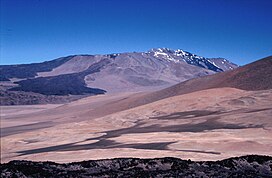Серро Эль Кондор
| Серро Эль Кондор | |
|---|---|
 Серро эль -Кондор с востока | |
| Самая высокая точка | |
| Возвышение | 6414 м (21 043 фута) [ 1 ] |
| Известность | 1660 м (5450 футов) [ 1 ] |
| Список | Ультра |
| Координаты | 26 ° 37′54 ″ S 68 ° 21′42 ″ W / 26,63167 ° S 68,36167 ° W [ 1 ] |
| География | |
| Location | Argentina |
| Parent range | Andes |
| Geology | |
| Age of rock | Holocene |
| Mountain type | Stratovolcano |
| Climbing | |
| First ascent | Alexander von Götz, Steffen Salzmann, et al., 2003 |
Серро -эль -Кондор - стратоволкано в Аргентине .
Серро -эль -Кондор - отдаленный пик в аргентинской пуна -де -атакаме. Таким образом, это был, вероятно, последний мажный 6000 м+ пик в Андах, который нужно подняться, [ 2 ] С вершиной достигает высоты 6400 метров (21 000 футов). Вулкан имеет форму массива (который охватывает поверхность 281 квадратных километров (108 кв. Миль)), построенной двумя отдельными вулканами; Старшее здание образует части северного и восточного фланга, которые вырезаны Scarps, интерпретируемыми как остатки кальдеры. [ 3 ] Область вершины образуется новым зданием и оснащена серией кратеров с диаметрами 100–350 метров (330–1150 футов) и крышкой пирокластического материала и Scoria . Также частью более новой фазы являются обширные потоки лавы, которые образуют западные и части восточных и южных склонов и достигают расстояний 17 километров (11 миль) от вершины. [ 4 ]
Surrounding volcanoes include Condorito (which is considered to be part of the old El Cóndor volcano), Falso Azufre and Laguna Escondida which have constrained the extent of El Cóndor's lava flows. The volcano rises within the Laguna Amarga caldera,[3] and an older mafic monogenetic volcano lies north of El Cóndor.[4]
Radiometric dating has yielded ages of 2.89 - 2.67 million years ago to 0.13 - 0.02 million years ago,[5] with the volcano developing in two phases.[3] The older group of ages has been obtained on the Condorito and the older edifice, while the ages of 130,000 years ago and younger come from the younger edifice and lava flows; some of these dates have high uncertainties (one young age is 20,000 ± 30,000 years ago from the western flank)[6] and Holocene eruptions in the summit region are possible. Presently, Cóndor is considered to be a dormant volcano with the potential of future activity, and while the remoteness of the volcano reduces any hazard potential future pyroclastic eruptions could impact air traffic over the region and east of it.[7]
Cerro El Cóndor is part of the Central Volcanic Zone of the Andes together with about 110 other Quaternary volcanoes, and lies in the southern sector of the volcanic zone;[8] other volcanic zones in the Andes are the Northern Volcanic Zone, the Southern Volcanic Zone and the Austral Volcanic Zone.[9] The history of volcanic activity is poorly known for most of these volcanoes owing to the lack of dating; only a few historical eruptions have been recorded, such as an eruption at Ojos del Salado in 1993.[8]
The volcano has erupted trachyandesite and trachydacite in the later stages of activity, after a stage with andesitic to dacitic eruptions.[10] The rocks define a potassium-rich calc-alkaline suite.[4]
See also
[edit]- List of volcanoes in Argentina
- List of mountains in Argentina
- List of mountains in the Andes
- List of Ultras of South America
References
[edit]- ^ Jump up to: a b c "Argentina and Chile North: Ultra-Prominences" Peaklist.org. Retrieved 2013-02-25.
- ^ Biggar, John (2020). The Andes: A Guide for Climbers and Skiers (5th ed.). Andes Publishing (Scotland). pp. 221, 329 pp. ISBN 978-0-9536087-6-8.
- ^ Jump up to: a b c Grosse et al. 2018, p.14
- ^ Jump up to: a b c Grosse et al. 2018, p.15
- ^ GROSSE, Pablo; GUZMÁN, Silvina; PETRINOVIC, Ivan (2017). "VOLCANES COMPUESTOS CENOZOICOS DEL NOROESTE ARGENTINO" (PDF). ResearchGate (in Spanish). Tucuman: 20th Chilean Geological Congress. p. 508. Retrieved 20 January 2018.
- ^ Grosse et al. 2018, pp.16-17
- ^ Grosse et al. 2018, p.19
- ^ Jump up to: a b Grosse et al. 2018, p.2
- ^ Grosse et al. 2018, p.3
- ^ Grosse et al. 2018, p.7
Источники
[ редактировать ]- «Эль -Кондор» . Глобальная программа вулканизма . Смитсоновский институт . Получено 2021-06-28 .
- Гросс, Пол; Орихаши, Юджи; Гусман, Сильвина Р.; Призыв, Хирочика; Нагао, Кейсуке (1 мая 2018 года). "Наши центральные Анды" Бюллетень вулканологии 80 (5): 10.1007 / s0045-018-1221-5 44. HDL : 10261/163641 . ISSN 0258-8



